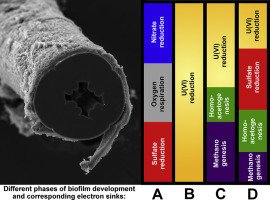当前位置:
X-MOL 学术
›
Water Res.
›
论文详情
Our official English website, www.x-mol.net, welcomes your feedback! (Note: you will need to create a separate account there.)
Total electron acceptor loading and composition affect hexavalent uranium reduction and microbial community structure in a membrane biofilm reactor
Water Research ( IF 12.8 ) Pub Date : 2017-08-29 , DOI: 10.1016/j.watres.2017.08.060 Aura Ontiveros-Valencia , Chen Zhou , Zehra Esra Ilhan , Louis Cornette de Saint Cyr , Rosa Krajmalnik-Brown , Bruce E. Rittmann
Water Research ( IF 12.8 ) Pub Date : 2017-08-29 , DOI: 10.1016/j.watres.2017.08.060 Aura Ontiveros-Valencia , Chen Zhou , Zehra Esra Ilhan , Louis Cornette de Saint Cyr , Rosa Krajmalnik-Brown , Bruce E. Rittmann

|
Molecular microbiology tools (i.e., 16S rDNA gene sequencing) were employed to elucidate changes in the microbial community structure according to the total electron acceptor loading (controlled by influent flow rate and/or medium composition) in a H2-based membrane biofilm reactor evaluated for removal of hexavalent uranium. Once nitrate, sulfate, and dissolved oxygen were replaced by U(VI) and bicarbonate and the total acceptor loading was lowered, slow-growing bacteria capable of reducing U(VI) to U(IV) dominated in the biofilm community: Replacing denitrifying bacteria Rhodocyclales and Burkholderiales were spore-producing Clostridiales and Natranaerobiales. Though potentially competing for electrons with U(VI) reducers, homo-acetogens helped attain steady U(VI) reduction, while methanogenesis inhibited U(VI) reduction. U(VI) reduction was reinstated through suppression of methanogenesis by addition of bromoethanesulfonate or by competition from SRB when sulfate was re-introduced. Predictive metagenome analysis further points out community changes in response to alterations in the electron-acceptor loading: Sporulation and homo-acetogenesis were critical factors for strengthening stable microbial U(VI) reduction. This study documents that sporulation was important to long-term U(VI) reduction, whether or not microorganisms that carry out U(VI) reduction mediated by cytochrome c3, such as SRB and ferric-iron-reducers, were inhibited.
中文翻译:

电子受体的总负载量和组成影响膜生物膜反应器中六价铀的还原和微生物群落结构
根据评估的H 2基膜生物膜反应器中的总电子受体负荷(受进水流速和/或培养基组成控制),使用分子微生物学工具(即16S rDNA基因测序)阐明微生物群落结构的变化。用于去除六价铀。一旦用U(VI)和碳酸氢盐代替了硝酸盐,硫酸盐和溶解的氧,并且降低了总受体的负载,能够将U(VI)还原为U(IV)的缓慢生长的细菌就占据了生物膜群落的主导地位:替代反硝化细菌杜鹃花和伯克霍尔德氏菌是产孢子的梭状芽孢杆菌和纳特罗伯阿波罗虫。。尽管潜在地与U(VI)还原剂竞争电子,但是均相乙酸原有助于实现U(VI)的稳定还原,而甲烷生成抑制了U(VI)的还原。通过添加溴乙烷磺酸盐或通过重新引入硫酸盐时与SRB竞争来抑制甲烷生成,从而恢复了U(VI)还原。预测性的基因组分析进一步指出了响应电子受体负荷变化的群落变化:孢子形成和均相产乙酸是加强稳定的微生物U(VI)还原的关键因素。这项研究表明,孢子形成对于长期减少U(VI)很重要,无论是否抑制了由细胞色素c 3介导的进行U(VI)减少的微生物,例如SRB和铁还原剂。
更新日期:2017-08-30
中文翻译:

电子受体的总负载量和组成影响膜生物膜反应器中六价铀的还原和微生物群落结构
根据评估的H 2基膜生物膜反应器中的总电子受体负荷(受进水流速和/或培养基组成控制),使用分子微生物学工具(即16S rDNA基因测序)阐明微生物群落结构的变化。用于去除六价铀。一旦用U(VI)和碳酸氢盐代替了硝酸盐,硫酸盐和溶解的氧,并且降低了总受体的负载,能够将U(VI)还原为U(IV)的缓慢生长的细菌就占据了生物膜群落的主导地位:替代反硝化细菌杜鹃花和伯克霍尔德氏菌是产孢子的梭状芽孢杆菌和纳特罗伯阿波罗虫。。尽管潜在地与U(VI)还原剂竞争电子,但是均相乙酸原有助于实现U(VI)的稳定还原,而甲烷生成抑制了U(VI)的还原。通过添加溴乙烷磺酸盐或通过重新引入硫酸盐时与SRB竞争来抑制甲烷生成,从而恢复了U(VI)还原。预测性的基因组分析进一步指出了响应电子受体负荷变化的群落变化:孢子形成和均相产乙酸是加强稳定的微生物U(VI)还原的关键因素。这项研究表明,孢子形成对于长期减少U(VI)很重要,无论是否抑制了由细胞色素c 3介导的进行U(VI)减少的微生物,例如SRB和铁还原剂。



























 京公网安备 11010802027423号
京公网安备 11010802027423号